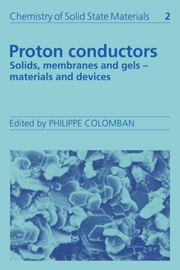Book contents
- Frontmatter
- Contents
- List of contributors
- Preface
- Symbols
- I HYDROGEN BOND AND PROTONIC SPECIES
- II MATERIALS: PREPARATION, STRUCTURES AND PROPERTIES
- 7 Structure and characterization of hydrogen insertion compounds of metal oxides
- 8 High temperature proton conductors based on perovskite-type oxides
- 9 Highly ionic hydroxides: unexpected proton conductivity in Mg(OH)2 and homologues
- 10 Ice
- 11 Anhydrous materials: oxonium perchlorate, acid phosphates, arsenates, sulphates and selenates
- 12 Hydrogen behaviour in graphite–nitric acid intercalation compounds
- 13 Proton-containing β- and β″-alumina structure type compounds
- 14 Proton conduction in zeolites
- 15 Proton containing NASICON phases
- 16 Phosphates and phosphonates of tetravalent metals as protonic conductors
- 17 Hydrogen uranyl phosphate, H3OUO4PO4. 3H2O (HUP), and related materials
- 18 From crystalline to amorphous (particle) hydrates: inorganic polymers, glasses, clays, gels and porous media
- 19 Perfluorinated membranes
- 20 Mixed inorganic-organic systems: the acid/polymer blends
- III PROTON DYNAMICS AND CHARGE TRANSPORT
- IV PROTON DIFFUSION MECHANISMS
- V DEVICES
- Index
19 - Perfluorinated membranes
Published online by Cambridge University Press: 04 May 2010
- Frontmatter
- Contents
- List of contributors
- Preface
- Symbols
- I HYDROGEN BOND AND PROTONIC SPECIES
- II MATERIALS: PREPARATION, STRUCTURES AND PROPERTIES
- 7 Structure and characterization of hydrogen insertion compounds of metal oxides
- 8 High temperature proton conductors based on perovskite-type oxides
- 9 Highly ionic hydroxides: unexpected proton conductivity in Mg(OH)2 and homologues
- 10 Ice
- 11 Anhydrous materials: oxonium perchlorate, acid phosphates, arsenates, sulphates and selenates
- 12 Hydrogen behaviour in graphite–nitric acid intercalation compounds
- 13 Proton-containing β- and β″-alumina structure type compounds
- 14 Proton conduction in zeolites
- 15 Proton containing NASICON phases
- 16 Phosphates and phosphonates of tetravalent metals as protonic conductors
- 17 Hydrogen uranyl phosphate, H3OUO4PO4. 3H2O (HUP), and related materials
- 18 From crystalline to amorphous (particle) hydrates: inorganic polymers, glasses, clays, gels and porous media
- 19 Perfluorinated membranes
- 20 Mixed inorganic-organic systems: the acid/polymer blends
- III PROTON DYNAMICS AND CHARGE TRANSPORT
- IV PROTON DIFFUSION MECHANISMS
- V DEVICES
- Index
Summary
Historical background and development
Electrochemical cells (electrolysers, batteries and fuel cells) require separators, which allow a flow of specific ionic charges but prevent the transfer of chemical species which remain located either in the cathodic or in the anodic compartment. Among the various separators of electrochemical cells, the ion permeable organic membranes are also used for separation processes such as dialysis and electrodialysis.
Ion permeable organic membranes are polymer films made from ion exchange material. Their thickness is between 50 and 200 um. The polymeric matrix contains fixed ionic groups (the functional sites) the charges of which are compensated by mobile ions (the counter-ions) which can be exchanged with adjoining media. In contact with an aqueous electrolyte solution, ion permeable membranes contain also water and sorbed electrolytes. Monofunctional membranes are ion permselective. The fixed sites of cation permeable membranes are sulphonic or carboxylic groups; those of anion permeable membranes are amine or quaternary ammonium groups.
Among the cation permeable membranes, the perfluorinated membranes which have been developed as separators for fuel cells and chlor-alkali electrolysers show the characteristic features of superselectivity, very high thermal stability and chemical resistance, which are not obtained by the other classes of polymeric ion permeable membranes. Three commercial forms of cation permeable perfluorinated membranes have been proposed:
the Nafion® monofunctional perfluorosulphonic membrane produced by Du Pont de Nemours,
the Flemion® perfluorocarboxylic membrane produced by Asahi Glass,
the Tokuyama Soda bifunctional membrane (both perfluorosulphonic and carboxylic).
- Type
- Chapter
- Information
- Proton ConductorsSolids, Membranes and Gels - Materials and Devices, pp. 294 - 310Publisher: Cambridge University PressPrint publication year: 1992
- 19
- Cited by



